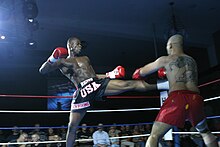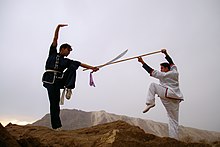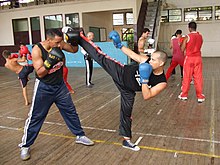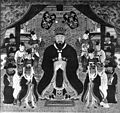The Martial Arts Portal

Martial arts are codified systems and traditions of combat practiced for a number of reasons such as self-defence; military and law enforcement applications; competition; physical, mental, and spiritual development; entertainment; and the preservation of a nation's intangible cultural heritage. (Full article...)
Although the earliest evidence of martial arts goes back millennia, the true roots are difficult to reconstruct. Inherent patterns of human aggression which inspire practice of mock combat (in particular wrestling) and optimization of serious close combat as cultural universals are doubtlessly inherited from the pre-human stage and were made into an "art" from the earliest emergence of that concept. Indeed, many universals of martial art are fixed by the specifics of human physiology and not dependent on a specific tradition or era.
Specific martial traditions become identifiable in Classical Antiquity, with disciplines such as shuai jiao, Greek wrestling or those described in the Indian epics or the Spring and Autumn Annals of China. (Full article...)
Selected articles
Selected biography
From 2004 until 2007, Asashōryū was sumo's sole yokozuna between the retirement of Musashimaru and the promotion of fellow Mongolian Hakuhō, and was criticized at times by the media and the Japan Sumo Association for not upholding the standards of behaviour expected of a holder of such a prestigious rank. He became the first yokozuna in history to be suspended from competition in August 2007 when he participated in a charity football match in his home country despite having withdrawn from a regional sumo tour claiming injury. After a career filled with a multitude of other controversies, both on and off the dohyō, his career was cut short when he retired from sumo in February 2010 after allegations that he assaulted a man outside a Tokyo nightclub. (Full article...)
Selected entertainment
Rocky Balboa is a 2006 American sports drama film starring, written and directed by Sylvester Stallone in his first film as director since 1985. It is the sequel to Rocky V (1990) and the sixth installment in the Rocky film series. The film co-stars Burt Young and Antonio Tarver in his only acting role. In the film, Rocky Balboa (Stallone), now an aging small restaurant owner, is challenged to an exhibition fight by hothead young boxer Mason Dixon (Tarver).
Development for a sixth Rocky film began after Stallone expressed regret of the outcome of Rocky V, which was viewed as a disappointing conclusion to the end of the franchise. Rocky Balboa includes references to characters and objects from previous installments, and Stallone was inspired by recent personal struggles and triumphs when writing the film. It is Stallone's first directorial effort since Rocky IV (1985) and is Tarver's only feature film appearance. Principal photography began in December 2005 and lasted until January 2006, with filming locations including Las Vegas, Los Angeles, and Philadelphia. In contrast to previous entries in the franchise, the fight choreography in Rocky Balboa was less scripted, featuring real punches thrown by Stallone and Tarver.
Rocky Balboa was theatrically released by MGM Distribution Co. in North America and 20th Century Fox internationally on December 20, 2006, thirty years after the release of the first film. Rocky Balboa received generally positive reviews from critics, with praise for its screenplay, Stallone's performance, and heartfelt exploration of Balboa's character, with many critics calling it a significant improvement over its predecessor, and many labelling the film one of the best entries in the franchise. It grossed over $156 million worldwide, surpassing expectations to rebound from the box office performance of its predecessor. A spin-off, Creed, was released in 2015 and kickstarted its own series, while a seventh mainline Rocky film is in development.
Sports portals
Selected image
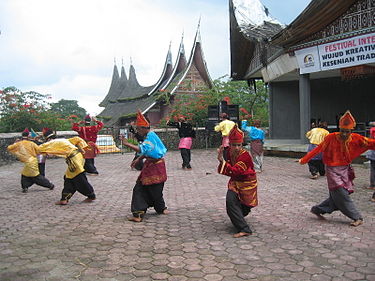 |
Randai (Jawi: رنداي) is a folk theater tradition of the Minangkabau ethnic group in West Sumatra, Indonesia, which incorporates music, singing, dance, drama and the martial art of silat. Randai is usually performed for traditional ceremonies and festivals, and complex stories may span a number of nights. It is performed as a theatre-in-the-round to achieve an equality and unity between audience members and the performers. Randai performances are a synthesis of alternating martial arts dances, songs, and acted-out scenes. Stories are delivered by both the acting and the singing and are mostly based upon Minangkabau legends and folktales. Randai originated early in the 20th century out of a fusion of local martial arts, story-telling, and other performance traditions. Men originally played both the male and female characters in the story, but since the 1960s, women have also participated. (Full article...)
General images -
Selected quote
Topics
- Regional origin - China - Europe - India - Indonesia - Japan - Korea - Philippines
- Unarmed techniques - Chokehold - Clinch - Footwork - Elbow strike - Headbutt - Hold - Kick - Knee strike - Joint lock - Punch - Sweep - Takedown - Throw
- Weapons - Archery - Duel - Knife fighting - Melee weapons - Shooting - Stick-fighting - Swordsmanship
- Training - Kata - Practice weapon - Punching bag - Pushing hands - Randori - Sparring
- Striking - Boxing - Capoeira - Karate - Kickboxing - Muay Thai - Lethwei - Sanshou - Savate - Taekwondo - Vovinam
- Internal - Aikido - Aikijutsu - Baguazhang - Tai chi - Xing Yi Quan
- Full contact / Combat sports - Professional boxing - Professional kickboxing - Knockdown karate - Mixed martial arts - Pankration - Submission wrestling
- Self-defense / Combatives - Arnis - Bartitsu - Hapkido - Kajukenbo - Krav Maga - MCMAP - Pencak Silat - Systema - Wing Chun - Legal aspects
- Eclectic / Hybrids - American Kenpo - Chun Kuk Do - Jeet Kune Do - Shooto - Shorinji Kempo - Unifight
Categories
Things you can do
See the list on the right of Martial art related projects who organise work on these articles. You can also add your self to the list of Wikipedians by martial art
Talk page tagging
If you come across a martial arts related article, adding the project template {{WikiProject Martial arts}} to the talk page will help identify them for improvement and linking to related articles. For Boxing, Fencing, Mixed martial arts and Sumo. Use {{WikiProject Boxing}}, {{WikiProject Fencing}}, {{WikiProject Mixed martial arts}} and {{WikiProject Sumo}} respectively.
- Assessment
- If possible please assess articles you tag using guidelines (Boxing, Mixed martial arts and Sumo).
Deletions
Monitor and contribute to deletion debates (Boxing).
Find images
Wikipedia requested images of martial artists, mixed martial artists and boxers.
Associated Wikimedia
The following Wikimedia Foundation sister projects provide more on this subject:
-
Commons
Free media repository -
Wikibooks
Free textbooks and manuals -
Wikidata
Free knowledge base -
Wikinews
Free-content news -
Wikiquote
Collection of quotations -
Wikisource
Free-content library -
Wikiversity
Free learning tools -
Wikivoyage
Free travel guide -
Wiktionary
Dictionary and thesaurus


